My Way or the High Way
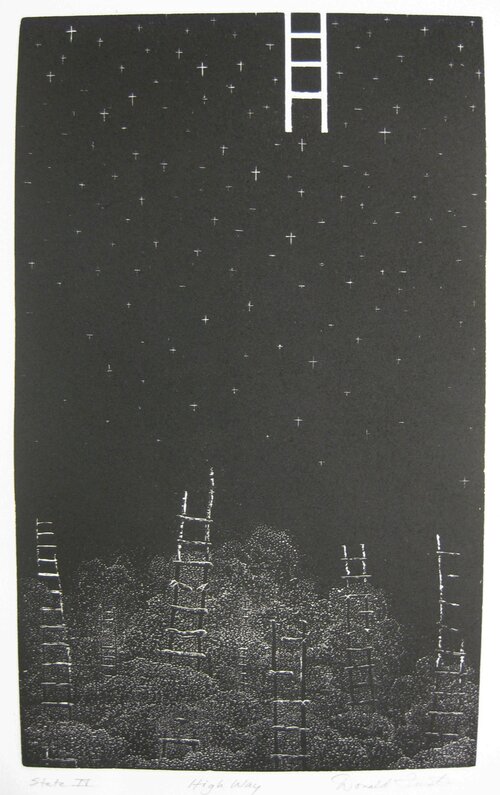
There are many ladders, rising from a woods that likely provided the branches for their construction. Each is rickety, rough-hewn, and does not inspire confidence that it would sustain the weight of the human being who was its craftsman. While the ladders stretch toward the stars, even the tallest barely reaches above the trees. That is the picture of futility we see in the bottom third of Donald Furst’s woodcut, “High Way.”
There is another ladder at the top of the image. It is pure white and perfectly formed – its right angles contrasting with the skewed rungs of the ladders below. Where they are reaching up, this ladder is descending, like Jacob’s ladder that linked heaven and earth. Indeed, its purity and perfection suggests it is of divine construction.
Above the trees is a field of stars. They seem to vary in intensity, but they share a common shape. The stars are all cruciform; the sky is filled with little crosses.
All aspects of the image combine to provide an artful presentation of spiritual truth. The Apostle Paul wrote to the Christians in Ephesus:
“For by grace you have been saved through faith, and that not of yourselves; it is the gift of God, not of works, lest anyone should boast.” (Eph. 2:8-9)
The rickety ladders in Furst’s woodcut are of human workmanship. They strive to reach a goal they can never attain. Salvation comes not through human works from below but through divine grace from above. God must provide it to us, as He provided Jacob’s ladder on which the angels ascended and descended.
But what is this ladder that will bridge the gap from earth below to heaven above? The stars provide the answer, as their cruciform shapes point us to Christ. Jesus drew on the image of Jacob’s ladder when He said to Nathanael:
“Most assuredly, I say to you, hereafter you shall see heaven open, and the angels of God ascending and descending upon the Son of Man.” (John 1:51)
Jesus Himself is the ladder upon which heaven comes to earth. On the cross, He defeated sin, death, and the devil, so that we might enter into heavenly life that begins now and will be consummated when heaven and earth are united in a new creation at His return.
The choice facing each human being is between trusting in his or her own works to reach heaven or trusting in the work of Jesus whom God has provided as the ladder of salvation. Each of us must answer the question posed by Furst’s image: My way or the High Way?
High Way, by Donald Furst. Woodcut. 13 x 8 inches. Used by permission of the artist. (www.donaldfurst.com)
True Pilgrims, True Thanksgiving
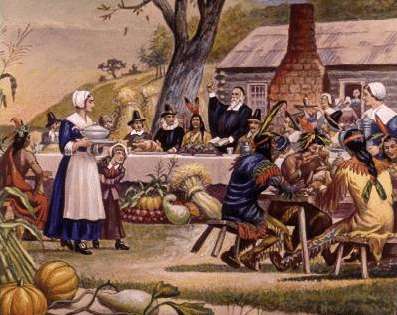
Once again, the Thanksgiving holiday is upon us and our minds are filled with images of pilgrims and pumpkin pie. All across our nation it is a time of family gatherings, feasting, and football. Such celebration can be good and godly, but it can best be these things if we remember the holiday’s origins and truly enter into the spirit of giving thanks. The pilgrims have much to teach us about thanksgiving.
Who were these people we know as the pilgrims? They were Puritans who felt conscience-bound to separate from the Church of England when that church in 1604 demanded strict conformity to the Book of Common Prayer in worship. These Puritans longed for a more thoroughgoing Reformation in order to worship only in ways clearly mandated in Scripture. At first, they worshiped secretly in homes in England, but persecution was on the rise. One such group in the town of Scrooby soon realized that they would have to leave the country in order to worship freely. They went first to Holland, but troubles there signaled time for another move. When the Mayflower set sail for America in 1620, 37 of its 102 passengers were Puritan Separatists from Scrooby that had settled in Holland. Many in the community stayed behind in Holland with their pastor, John Robinson, intending to join their friends and loved ones in America later on.
The two-month trans-Atlantic voyage was often rough and miserable, and things only got worse when they reached the New World in November. They began building their settlement in the midst of a deadly winter, through which only 55 of the 102 passengers survived. Eight children who had come with at least one parent now had none. Of 18 adult women, only four survived. Many reunions planned with those left behind in Holland would now take place only in heaven. It was a bitter beginning.
Spring and summer brought a peace treaty with the Indians, who helped teach the settlers how to farm in the New World. Crops were limited but sufficient for survival when combined with the fruits of foraging and hunting. When the harvest came in, there was a three-day celebration by about 50 settlers and 90 native Americans. It was a time of feasting, recreation, and giving thanks to God for the blessings of the harvest. This celebration is commemorated by our Thanksgiving holiday.
How was it that these settlers could be so thankful after all the tragic losses of the previous year? I suggest it was because they were true pilgrims. They didn’t generally refer to themselves in this way. The closest they came to doing so is a statement by William Bradford in his book, Of Plymouth Plantation:
So they left that goodly and pleasant city [Leyden in Holland] which had been their resting place near twelve years; but they knew they were pilgrims, and looked not much on those things, but lift up their eyes to heaven, their dearest country, and quieted their spirits.
This language echoes that of Hebrews 11.13-14, which speaks of believers as “strangers and pilgrims on the earth” who “seek a [heavenly] homeland.” The Separatists from Scrooby were pilgrims in the same way Bunyan’s character, Christian, was a pilgrim. They were pilgrims on earth making their way to the Celestial City. That eternal perspective made it possible for them to experience such great sorrow through the winter and yet emerge thankful for the good things God gave to them.
If we would celebrate Thanksgiving in the spirit of these early settlers, we also should cultivate an identity as pilgrims on earth making our way to the heavenly city. When sorrows come to us, we can know that God is with us in them and that they will not last forever. We can give Him thanks for every good gift He sends our way.
When you gather with your family and friends on Thanksgiving Day, remember these pilgrims and their harvest feast of celebration before God. Review the past year with its blessings and hardships, and reflect on God’s faithfulness to you in it. Offer sincere and specific prayers of thanksgiving to the Lord who is leading you on your pilgrimage. And then, like those pilgrims of old, enjoy the feasting and fun that should characterize your Christian faith.
2023 Reformation Conference
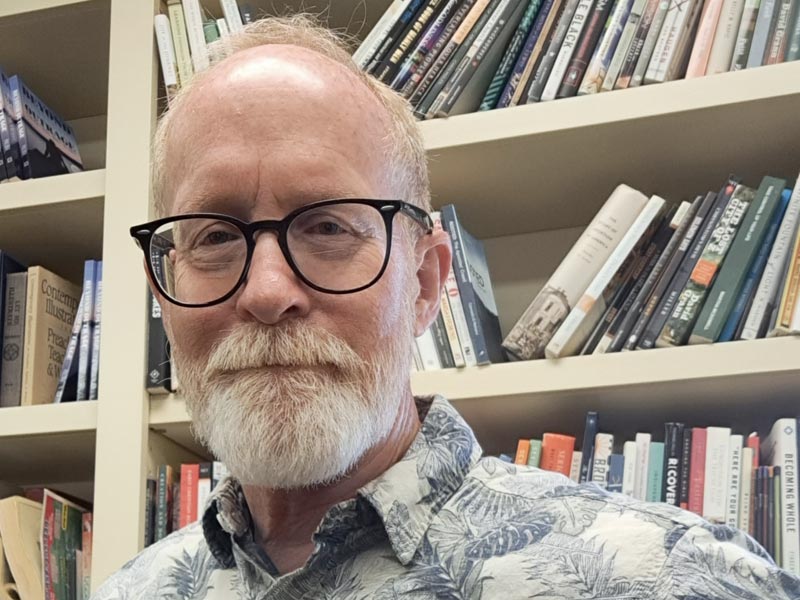
Pastor Michael Philliber is pastor of Heritage Presbyterian Church (PCA) in Oklahoma City, OK. After spending 20 years in the USAF.
Continue readingWilliam Shatner and King David: Contrasting Worldviews
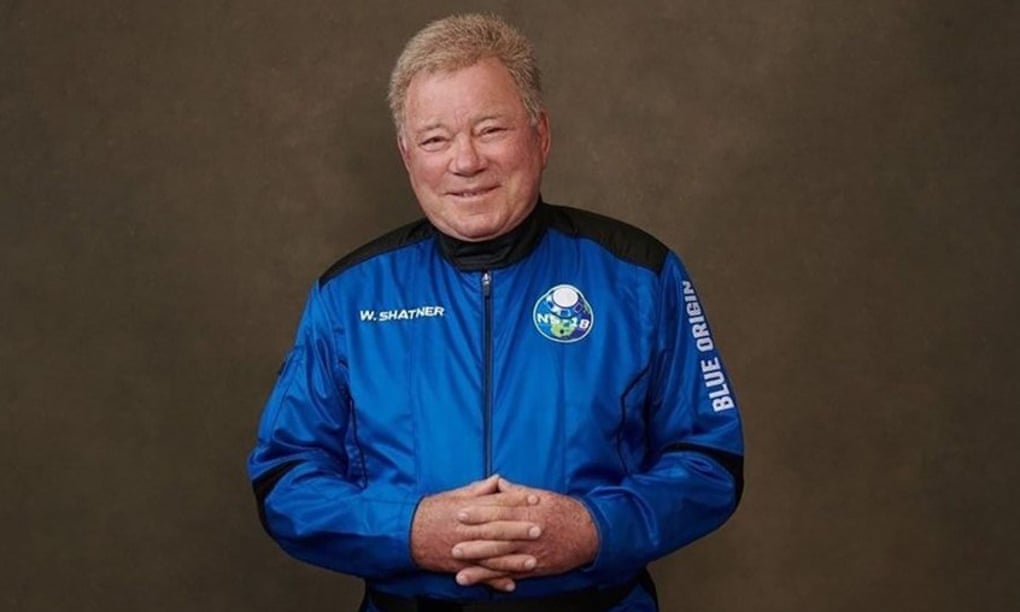
William Shatner is most known for his acting role as Captain James T. Kirk of the Starship Enterprise on the long-running television series, Star Trek, and the movies that followed. He also holds the title as the oldest human being to fly into space. He did so at the age of 90 aboard Jeff Bezos’s Blue Origin sub-orbital capsule. In a recent interview, Shatner commented on the impact that experience had upon him:
What I experienced was not so much the flight into space, but my observation. Everybody knows we live on a small rock and that up to 12,500 feet oxygen is there. And after that, as you go higher, you get into a dead zone…. We live on a small rock. I saw the beginning of the curvature of the Earth. If I followed through, I could make a circle of this rock we live on. We are so negligible. We are so nothing. We are this small rock and this negligible solar system which is beside a mediocre star in a galaxy that is barely larger. We’re nothing. We are nothing, and that’s what I saw.
In a way, William Shatner had an experience similar to that of King David as recorded in Psalm 8. But while Shatner was looking from space upon Earth, David was looking from Earth into space. In his poem directed to God he wrote:
When I consider Your heavens, the work of Your fingers,
The moon and the stars, which You have ordained,
What is man that You are mindful of him,
And the son of man that You visit him?
There is nothing new about observing the vastness of the universe and reflecting upon the apparent insignificance of human beings upon Earth. The implication of David’s question to God is that he was tempted to draw the same conclusion as Shatner: “We are so negligible. We are so nothing.”
However, neither the modern actor nor the ancient king was entirely satisfied with that deduction. Here is the full conclusion of what William Shatner said:
We’re nothing. We are nothing, and that’s what I saw. And what else I saw was the tragedy of the extinction of life.
These two observations are difficult to reconcile. If life on earth is really nothing, then what is so tragic about the extinction of life on earth? Shatner went on to note that he has long been interested in ecology, but one has to wonder why that would be the case. On the presupposition that our planet and its living inhabitants are nothing, the extinction of life on the planet should be absolutely meaningless. If nothing becomes nothing, what is lost? And yet he sees such an event as tragic.
I suggest that is because, in his heart of hearts, William Shatner knows we are really not nothing. He knows what King David proceeded to declare to the Lord after posing his apparently despairing question:
You have made [man] a little lower than the angels,
And You have crowned him with glory and honor.
Despite the smallness of man against the backdrop of the vast universe, David recognized that mankind has an exalted status in the cosmos. He was created a “little lower than Elohim,” which can be translated either as God or angels. And he has been “crowned with glory and honor” by God Himself. Such is God’s view of the only creatures He made in His own image (Genesis 1.26).
David further reflected upon how man’s exalted status is demonstrated in the authority and responsibilities entrusted to him by God:
You have made him to have dominion over the works of Your hands;
You have put all things under his feet,
All sheep and oxen –
Even the beasts of the field,
The birds of the air,
And the fish of the sea
That pass through the paths of the seas.
It is on the basis of this dominion mandate that human beings have explored the world, extracted its resources, and applied accumulated knowledge such that the marvel of space travel has been achieved. Contrary to Shatner’s despairing conclusion, the Bible declares that we are not nothing but are, in fact, the pinnacle of creation exercising vicegerency over it in submission to God. It is because this planet is the good creation of God that extinction of life on earth is a tragedy. The Christian worldview provides a foundation for ecological concern that is not available to one who holds a materialistic/naturalistic worldview. To use the phraseology of apologist Cornelius Van Til, Shatner must borrow Christian capital to reach his conclusion. His own worldview is internally inconsistent.
King David, on the other hand, had a consistent worldview that undergirds the value of human exploration and ecological concern. And while seeing the value of man and his created environment, this worldview also looks beyond man to give credit where credit is due. Rather than ending in despair, David concludes his psalm on a note of praise:
O LORD, our Lord,
How excellent is Your name in all the earth!
Martin Luther King on the Complete Life
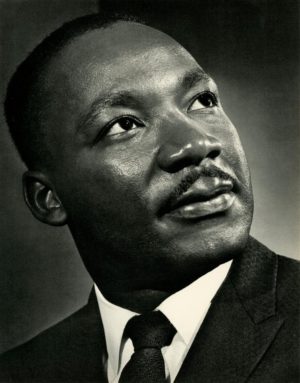
In the summer of 1958, Dr. Martin Luther King, Jr. delivered two devotional addresses to the first National Conference on Christian Education of the United Church of Christ at Purdue University.[1] I would like to revisit the second address entitled, “The Dimensions of a Complete Life.” In it, Dr. King helpfully provides a balanced view of how we are called to live as followers of Jesus Christ.
He begins by recalling John’s vision of the New Jerusalem descending to earth in Revelation 21. Dr. King notes that the completeness of the city was symbolized the equality of its length, breadth, and height – which make it a perfect cube. From that observation, he proceeds to discuss three “dimensions” of life to which we are all called to attend.
The first dimension is the personal, “in which the individual pursues personal ends and ambitions.” While moving too far in this dimension may lead to narcissism, it is nevertheless appropriate to have a proper self-regard and ambition. Dr. King describes how this should be the case in the vocational aspect of our lives: “No matter how small one thinks his life’s work is in terms of the norms of the world and the so-called big jobs, he must realize that it has cosmic significance if he is serving humanity and doing the will of God.” This is a helpful corrective to false thinking that views some callings as more significant than others in the eyes of God. He provides an effective illustration to make his point:
To carry this to an extreme, if it falls to your lot to be a street-sweeper, sweep streets as Raphael painted pictures, sweep streets as Michelangelo carved marble, sweep streets as Beethoven composed music, sweep streets as Shakespeare wrote poetry. Sweep streets so well that all the hosts of heaven and earth will have to pause and say, “Here lived a great street-sweeper who swept his job well.”
In the personal dimension of life, we are called to be the best that we can be when that is kept in balance with the other dimensions.
The second dimension of life has to do with others. It is absolutely essential that we attend to it: “An individual has not started living until he can rise above the narrow confines of his individualistic concerns to the broader concerns of all humanity.” Dr. King relates Jesus’ parable of the good Samaritan, comparing what thinking might have been behind the responses of the priest and Levite on the one hand and the Samaritan on the other:
I imagine the first question that the priest and the Levite asked was this: “If I stop to help this man, what will happen to me?” Then the good Samaritan came by, and by the very nature of his concern reversed the question: “If I do not stop to help this man, what will happen to him?” And so this man was great because he had the mental equipment for a dangerous altruism.
Dr. King warns against focusing exclusively on our personal concerns, instead calling us to recognize “that we are all caught in an inescapable network of mutuality.” Like the Samaritan man in the parable, we must be willing to place the needs of others above our own – at times even engaging in “a dangerous altruism.”
The third dimension has to do with our relationship with God. Dr. King observes that some people master the first two dimensions without ever getting around to the third. When they do this, “They find themselves bogged down on the horizontal plane without being integrated on the vertical plane.” No life is complete that leaves God out of the picture. And yet, he notes that it is easy to forget this in our modern world:
We so often find ourselves neglecting this third dimension of life. Not that we go up and say, “Good-by, God, we are going to leave you now.” But we become so involved in the things of this world that we are unconsciously carried away by the rushing tide of materialism which leaves us treading in the confused waters of secularism.
How that description rings true to the temptation that comes to those of us ensconced in the middle class American lifestyle! When our basic personal needs seem always to be provided, we often have little thought for God. But, as Dr. King writes, “Without him, life is a meaningless drama with the decisive scenes missing.” Hence, he issues a call for all to seek and to nurture a relationship with God.
Not only is this presentation helpful in terms of it personal application in our lives; it is also salutary when we look back and evaluate the life and work of Dr. King himself. Because of his leadership in the Civil Rights movement, it might be thought that his attention was focused exclusively on the second dimension – raising the life conditions of others who were being mistreated as victims of racial prejudice. But he was also interested in the first dimension, challenging every individual to embrace his or her calling with a larger vision in mind. And the third dimension was absolutely essential to this ordained minister. The ultimate goal for all people involved not just horizontal equality but vertical reconciliation. No life could be complete without a right relationship with God.
Consider, in closing, Dr. King’s summary of his vision of the three dimensions of the complete life:
Love yourself, if that means rational, healthy, and moral self-interest. You are commanded to do that. That is the length of life. Love your neighbor as you love yourself. You are commanded to do that. That is the breadth of life. But never forget that there is a first and even greater commandment, “Love the Lord thy God with all thy heart and all thy soul and all thy mind.” This is the height of life. And when you do this you live the complete life.
[1]All quotations are from the published version of these two addresses: Martin Luther King, Jr., The Measure of a Man(Mansfield Centre, CT: Martino Publishing, 2013).
Christmas and the Conquering Christ

For unto us a Child is born, unto us a Son is given; and the government will be upon His shoulder. And his name will be called Wonderful, Counselor, Mighty God, Everlasting Father, Prince of Peace. Of the increase of His government and peace there will be no end, upon the throne of David and over His kingdom, to order it and establish it with judgment and justice from that time forward, even forever.
Isaiah 9:6-7 (NKJV)
Birth of a Conqueror
Christmas celebrates the birth of a mighty conqueror. It is easy to lose sight of this amidst the sights and sounds of the season, and it is not just commercialism and the secular trappings of the holiday that can have this effect. Ubiquitous nativity scenes and carols focused on the baby Jesus can lure us into a kind of sappy sentimentalism that forgets just who this baby was and why He was born in Bethlehem all those years ago. Even many unbelievers join in the holiday spirit, because they don’t find anything threatening about a baby in a manger (though they should). Earlier generations did not forget the truth that Jesus came as a mighty conqueror. This theme finds exquisite expression in John Milton’s poem, “On the Morning of Christ’s Nativity,” composed in 1629.
Christmas Victory Over Pagan Gods
Milton’s 27-stanza ode celebrates Christ’s birth as a time of victory over pagan deities in all their forms. The poet provides a veritable catalog of ancient competitors to Christ. He speaks of deities we read about in the Old Testament, such as Baal and Peor and Moloch. He references mythic beings like Nymphs and the gods of Egypt, Libya, and Rome. All of these, Milton proposes, began to be swept aside when Jesus was born in Bethlehem. We get a taste of Milton’s art in a stanza that begins by speaking of the Egyptian god, Osiris, and goes on to mention Typhon, a giant monster in Greek myth. Speaking first of Osiris, Milton writes:
He feels from Juda’s land
The dredded Infants hand,
The rayes of Bethlehem blind his dusky eyn;
Nor all the gods beside,
Longer dare abide,
Nor Tryphon huge ending in snaky twine:
Our Babe to show his Godead true,
Can in his swaddling bands controul the damned crew.
The “Godhead true” of baby Jesus exposes as false the pretensions to godhead of all the pagan deities. Even in “his swaddling bands,” Jesus had the full power to “controul the damned crew.” Milton rightly saw in Christmas the victory of Christ over all His competitors.
Christmas Victory Over Satan
Chief among these competitors, of course, is Satan himself. Milton anticipates the perfect bliss that will come with victory over the devil at the last judgment, but he sees that bliss beginning to be realized in Christ’s nativity:
And then at last our bliss
Full and perfect is,
But now begins: for from this happy day
Th’ old Dragon under ground,
In straiter limits bound,
Not half so far casts his usurped sway,
And wrath to see his Kingdom fail,
Swindges the scaly Horrour of his foulded tail.
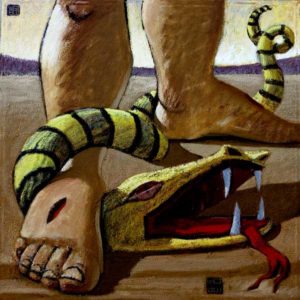 Jesus was born to vanquish Satan’s kingdom (“his usurped sway”) and to establish the Kingdom of God. This is the testimony of Scripture. Immediately after His baptism, Jesus confronted Satan in the wilderness and wielded the Word of God as a weapon to resist his temptations. When Jesus cast an unclean spirit out of a man in the Capernaum synagogue, the spirit cried out:
Jesus was born to vanquish Satan’s kingdom (“his usurped sway”) and to establish the Kingdom of God. This is the testimony of Scripture. Immediately after His baptism, Jesus confronted Satan in the wilderness and wielded the Word of God as a weapon to resist his temptations. When Jesus cast an unclean spirit out of a man in the Capernaum synagogue, the spirit cried out:
“What have we to do with you, Jesus of Nazareth? Did you come to destroy us? I know who You are – the Holy One of God!” (Mark 1:24, NKJV).
When Jesus approached the Gadarene demoniacs, the demons cried out:
“What have we to do with You, Jesus, You Son of God? Have You come here to torment us before the time?” (Matthew 8:29)
The demons clearly recognized Jesus for who He was, and they knew He had come to rout them. With every exorcism, Jesus displayed His power over Satan and his forces. When some scribes from Jerusalem accused Jesus of casting out demons by the power of Beelzebub, He responded:
“How can Satan cast out Satan? If a kingdom is divided against itself, that kingdom cannot stand. And if a house is divided against itself, that house cannot stand. And if Satan has risen up against himself, and is divided, he cannot stand, but has an end. No one can enter a strong man’s house and plunder his goods, unless he first binds the strong man. And then he will plunder his house.” (Mark 3:23-27, NKJV)
This is exactly what Jesus was doing – binding Satan and plundering his house. During His earthly ministry, Jesus bound Satan for a thousand years so that he would no longer deceive the nations (cf. Revelation 20:1-3). Milton referred to this when he wrote:
Th’ old Dragon under ground,
In straiter limits bound,
Not half so far casts his usurped sway.
The Ongoing Christmas Conquest
With Satan now bound, the gospel is going forth in power, and people from every nation are coming to faith in Christ. We read in Revelation 20 not only of Satan’s binding in history but also of his fate at the end of history:
The devil, who deceived them, was cast into the lake of fire and brimstone where the beast and the false prophet are. And they will be tormented day and night forever and ever. (Revelation 20:10, NKJV)
This is where history is headed as Jesus vanquishes the kingdom of Satan and builds the Kingdom of God. This victorious march through history began when Jesus took flesh upon Himself and was born as a baby in Bethlehem. Milton reminded us of the Person and the power of the newborn child in Bethlehem:
Our Babe to shew his Godhead true,
Can in his swaddling bands controul the damned crew.
It is good and right to celebrate the birth of Jesus each year. There is surely a place for nativity scenes and carols about the little baby. But as you see such sights and sing such songs, remember that this baby who looked so helpless was in fact a mighty conqueror born to despoil Satan of his kingdom. He was God the Son come in the flesh to establish an everlasting Kingdom of righteousness, peace, and joy (Romans 14:17). He is your great King, and you will honor Him this Christmas as you bow before Him in worship and in wonder.
REFORMATION CONFERENCE
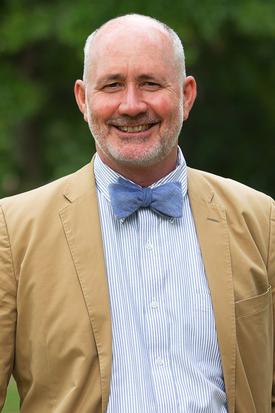
Reformation Conference 2022
Sunday, October 30th
Guest Speaker: Dr. Bradley G. Green
Theme: “Faith & Works: A Reformational Perspective”
Sunday Morning:
9:30 AM: Morning Worship Service
Sermon: “Justification and Divine Forbearance” (Ro. 3:21-26)
11:00 AM: Sunday School
“Faith and Works, Part I”
Sunday Afternoon:
12 Noon: Fellowship Meal (Fellowship Hall)
Sunday Evening:
5 PM: Evening Worship Service
“Faith and Works, Part II”
New Song Concert
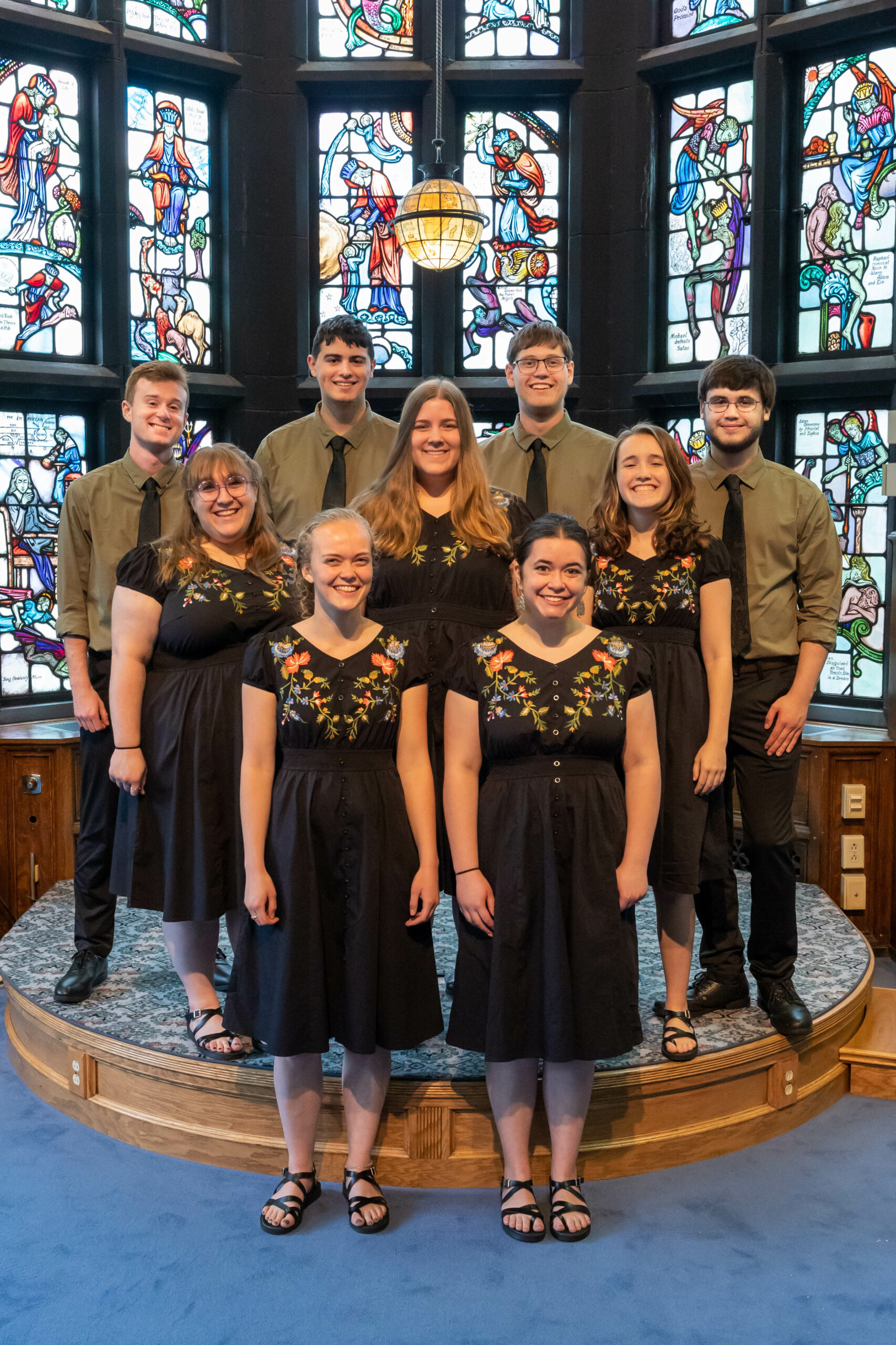
Covenant Presbyterian Church will host a concert by New Song on Sunday, July 10th, at 11 AM. New Song is a musical ministry of Geneva College (the denominational college of the Reformed Presbyterian Church of North America). Current student members carry on the 45 year New Song tradition featuring the a cappella singing of psalms and other church music.
You are invited to join us for worship at 9:30 AM followed by the concert at 11. Our address is 3720 N. Highland Avenue, Jackson, TN 38305.
Oh, sing to the LORD a new song!
Sing to the LORD, all the earth.
(Psalm 96:1)
Falling Angels: Painting and Poem
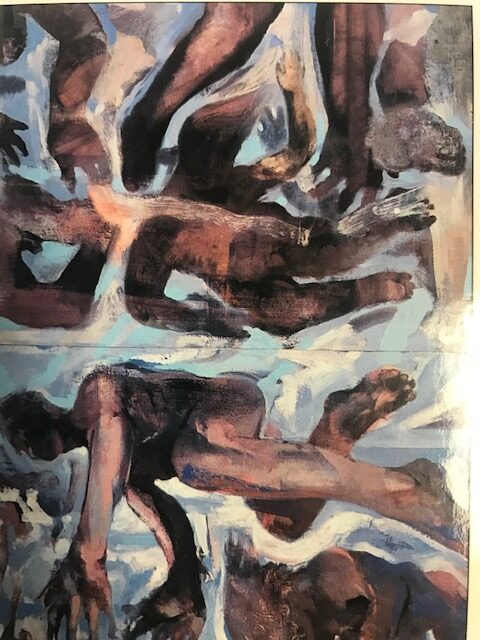
Falling Angels
After a painting by Bruce Herman
Lightning-fast,
the flailing figures
plummet through the heavens,
victims of a self-willed force –
the gravity of hubris.
Forsaking and forsaken,
their only choice is to embrace
with outstretched arms
the consequence of choices past.
But,
as if some law of conservation
maintained a cosmic metaphysics,
their hope lost
may be gained
by him who would strain his eyes to trace
their vapor trails of glory
upward.
Poem: © 2022, Steven C. Wright
Painting: Falling Angels, by Bruce Herman, 1993. Mixed Media. 44 x 30 inches. Used by permission of the artist. (www.bruceherman.com)
Easter Services
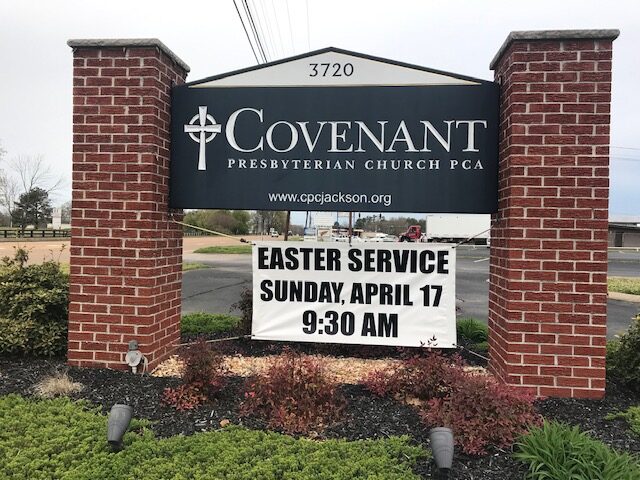
Psalm Sunday worship: Sunday, April 10th, 9:30 AM
Good Friday service: Friday, April 15th, 6:00 PM
Easter Sunday worship: Sunday, April 17th, 9:30 AM
Please plan to join us for these services celebrating Christ’s victory for our salvation accomplished through His death and resurrection.
